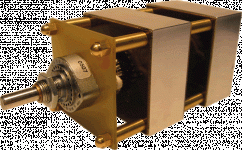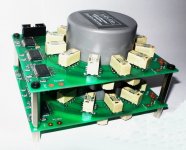Due to their diverse and conflicting fields autoformers are the least useful audio transformer devices. They are fine for power transformers.
Bud
Autoformer volume controls are great (for audio 😀); they need some treatment however to give off their best.
Well, "antenna event" sounds like a far field phenomena (radio waves), which normally requires wavelength like dimensions. Near field phenomena are just the usual induced voltages from mutual inductance and capacitance. The only thing approaching an audio wavelength here is the primary wire length. But I think the analysis given above shows this is not a real concern in audio OTs unless bifilar (and not on a single core).
I agree that the usual E and B fields need to be dealt with in a coherent manner to avoid leakage L and distributed C (at least with different voltages across it). And to avoid undamped HF resonances (ringing).
The typical autoformer would have poor leakage L with the secondary on one end of the total winding. It has to be wound with the same care (interleaving and E field isolation) as a typical audio OT for good performance. It can help some in reducing the total amount of copper in the windings, thus lowering leakage L a little if interleaved properly. No galvanic isolation though.
The bifilar or transmission line schemes (above) can minimise leakage L greatly and either match the voltages on each side of the bifilar (1st scheme) or incorporate the distributed C into a transmission line impedance (2nd scheme) that is tuned to the actual termination impedances. That it (2nd scheme) comes out electrically (diagram wise) looking like an autoformer is irrelevant really, its the coupling efficiency that counts. Although it certainly is inconvenient as far as galvanic isolation between primary to secondary.
-----------------------------------
Autotransformer volume controls work well because there is no real power being transferred. When the secondary does get loaded down for real power transfer, it (the opposing load current) pushes B fields out into the leakage L pathes, causing HF loss unless everything is interleaved. (which it isn't in the variable volume controls.)
I agree that the usual E and B fields need to be dealt with in a coherent manner to avoid leakage L and distributed C (at least with different voltages across it). And to avoid undamped HF resonances (ringing).
The typical autoformer would have poor leakage L with the secondary on one end of the total winding. It has to be wound with the same care (interleaving and E field isolation) as a typical audio OT for good performance. It can help some in reducing the total amount of copper in the windings, thus lowering leakage L a little if interleaved properly. No galvanic isolation though.
The bifilar or transmission line schemes (above) can minimise leakage L greatly and either match the voltages on each side of the bifilar (1st scheme) or incorporate the distributed C into a transmission line impedance (2nd scheme) that is tuned to the actual termination impedances. That it (2nd scheme) comes out electrically (diagram wise) looking like an autoformer is irrelevant really, its the coupling efficiency that counts. Although it certainly is inconvenient as far as galvanic isolation between primary to secondary.
-----------------------------------
Autotransformer volume controls work well because there is no real power being transferred. When the secondary does get loaded down for real power transfer, it (the opposing load current) pushes B fields out into the leakage L pathes, causing HF loss unless everything is interleaved. (which it isn't in the variable volume controls.)
Last edited:
They can be made to sound ok for ribbon tweeter matching transformers also. I had to use single turn foil secondaries, driven on both sides with 9 turns of copper wire and multiple layers of both connected in parallel for one of Bo Bingston's ginormous ribbon tweeter creations, sold by Red Rose a few years ago. The equivalent isolation device was audibly superior, but the engineer in charge decided to stick with the autoformer to avoid further enraging Bo.
I do have an early prototype of stepped volume control from Dave S. It has a strange garble to low level signals, but that is likely due to all of the flying coil leads randomly stuffed into an aluminum box.
Bud
I do have an early prototype of stepped volume control from Dave S. It has a strange garble to low level signals, but that is likely due to all of the flying coil leads randomly stuffed into an aluminum box.
Bud
There are some effects from a single localized air gap causing eddy currents in nearby windings or shields that could cause some sound problems too. The switched power supply xfmr designers are well familiar with that making hot spots. This would be a concern in SE xfmrs with the typical localized gap.
Distributed gaps would seem to be easy in toroids with an interleaved film in the core windup, but I seem to only hear about attempts at cutting the core.
Distributed gaps would seem to be easy in toroids with an interleaved film in the core windup, but I seem to only hear about attempts at cutting the core.
- Status
- Not open for further replies.

